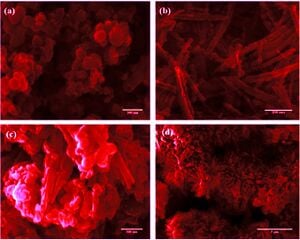
Titanium dioxide (TiO2) nanostructures (nanorods and nanoparticles) were prepared using a low-cost microwave irradiation method from a polyol medium of glycerol. Titanium glycerolate and TiO2 powders were obtained in the glycerol medium for the first time with four different power densities (240 W, 480 W, 720 W, 960 W) of irradiation using a domestic microwave oven of 2.45 GHz, to understand the impact of power on morphology tuning. The structural and morphological features of the titanium glycerolate and TiO2 powders were characterized by X-ray diffraction (XRD), field emission scanning electron microscopy (FESEM) and Raman spectra analysis. The TiO2 was successfully used in the fabrication of photovoltaic devices and as a proof-of-concept binder free paste was prepared and successfully employed for photo-anode using screen printing on the fluorine-doped tin oxide substrate.
Keywords[edit | edit source]
TiO2, microwave processing, binder free paste, screen printing, dye sensitized solar cell
See also[edit | edit source]
- Reaction Induced Multifunctional TiO2 Rod/Spherical Nanostructured Materials for Screen Printed Dye Sensitized Solar Cells
- Peanut shaped ZnO microstructures: controlled synthesis and nucleation growth toward low-cost dye sensitized solar cells
- Dual morphology titanium dioxide for dye sensitized solar cells
- Enhanced Dye-Sensitized Solar Cell Performance using Strontium Titanate Perovskite Integrated Photoanodes Modified with Plasmonic Silver Nanoparticles
- Microwave-Assisted Synthesized Gadolinium Doped Barium Strontium Titanate Nanostructures: Structural and Optical Properties for DSSC Applications
- Impact of Coupled Plasmonic Effect with Multishaped Silver Nanoparticles on Efficiency of Dye Sensitized Solar Cells
- The use of urea as an N-doping 3D hierarchical preserving agent for titanium dioxide nanostructures tailored for dye-sensitized solar cells
- Visible light driven photocatalytic performance of 3D TiO2/g-C3N5 nanocomposites via Z-scheme charge transfer promotion for water purification
- Fabrication of Bimetallic Inlaid Working Electrode for Highly Efficient Dye Sensitized Solar Cells





